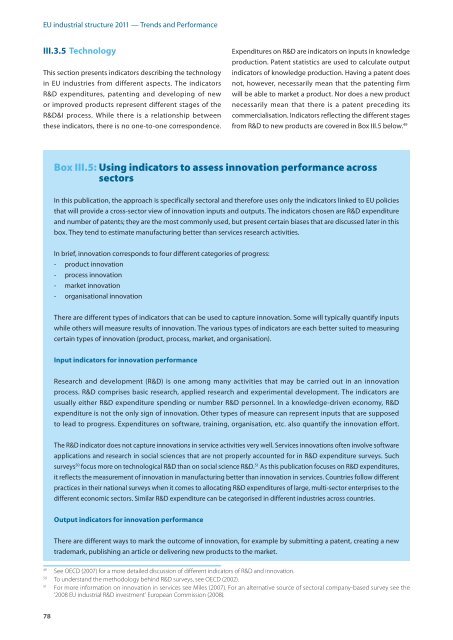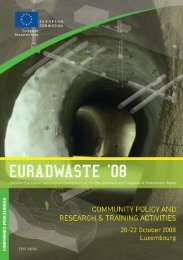EU industrial structure - EU Bookshop - Europa
EU industrial structure - EU Bookshop - Europa
EU industrial structure - EU Bookshop - Europa
You also want an ePaper? Increase the reach of your titles
YUMPU automatically turns print PDFs into web optimized ePapers that Google loves.
<strong>EU</strong> <strong>industrial</strong> <strong>structure</strong> 2011 — Trends and Performance<br />
iii35 technology<br />
This section presents indicators describing the technology<br />
in <strong>EU</strong> industries from different aspects. The indicators<br />
R&D expenditures, patenting and developing of new<br />
or improved products represent different stages of the<br />
R&D&I process. While there is a relationship between<br />
these indicators, there is no one‑to‑one correspondence.<br />
78<br />
Expenditures on R&D are indicators on inputs in knowledge<br />
production. Patent statistics are used to calculate output<br />
indicators of knowledge production. Having a patent does<br />
not, however, necessarily mean that the patenting firm<br />
will be able to market a product. Nor does a new product<br />
necessarily mean that there is a patent preceding its<br />
commercialisation. Indicators reflecting the different stages<br />
from R&D to new products are covered in Box III.5 below. 49<br />
box III.5: Using indicators to assess innovation performance across<br />
sectors<br />
In this publication, the approach is specifically sectoral and therefore uses only the indicators linked to <strong>EU</strong> policies<br />
that will provide a cross‑sector view of innovation inputs and outputs. The indicators chosen are R&D expenditure<br />
and number of patents; they are the most commonly used, but present certain biases that are discussed later in this<br />
box. They tend to estimate manufacturing better than services research activities.<br />
In brief, innovation corresponds to four different categories of progress:<br />
‑ product innovation<br />
‑ process innovation<br />
‑ market innovation<br />
‑ organisational innovation<br />
There are different types of indicators that can be used to capture innovation. Some will typically quantify inputs<br />
while others will measure results of innovation. The various types of indicators are each better suited to measuring<br />
certain types of innovation (product, process, market, and organisation).<br />
input indicators for innovation performance<br />
Research and development (R&D) is one among many activities that may be carried out in an innovation<br />
process. R&D comprises basic research, applied research and experimental development. The indicators are<br />
usually either R&D expenditure spending or number R&D personnel. In a knowledge‑driven economy, R&D<br />
expenditure is not the only sign of innovation. Other types of measure can represent inputs that are supposed<br />
to lead to progress. Expenditures on software, training, organisation, etc. also quantify the innovation effort.<br />
The R&D indicator does not capture innovations in service activities very well. Services innovations often involve software<br />
applications and research in social sciences that are not properly accounted for in R&D expenditure surveys. Such<br />
surveys50 focus more on technological R&D than on social science R&D. 51 As this publication focuses on R&D expenditures,<br />
it reflects the measurement of innovation in manufacturing better than innovation in services. Countries follow different<br />
practices in their national surveys when it comes to allocating R&D expenditures of large, multi‑sector enterprises to the<br />
different economic sectors. Similar R&D expenditure can be categorised in different industries across countries.<br />
Output indicators for innovation performance<br />
There are different ways to mark the outcome of innovation, for example by submitting a patent, creating a new<br />
trademark, publishing an article or delivering new products to the market.<br />
49 See OECD (2007) for a more detailed discussion of different indicators of R&D and innovation.<br />
50 To understand the methodology behind R&D surveys, see OECD (2002).<br />
51 For more information on innovation in services see Miles (2007). For an alternative source of sectoral company-based survey see the<br />
‘2008 <strong>EU</strong> <strong>industrial</strong> R&D investment’ European Commission (2008).
















